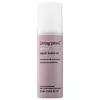What's inside
What's inside
 Key Ingredients
Key Ingredients

No key ingredients
 Benefits
Benefits

 Concerns
Concerns

 Ingredients Side-by-side
Ingredients Side-by-side

Water
Skin ConditioningCetyl Alcohol
EmollientGlycerin
HumectantIsoamyl Laurate
EmollientBehentrimonium Methosulfate
C13-15 Alkane
SolventOleyl Alcohol
EmollientYeast Amino Acids
HumectantLactobacillus Ferment
Skin ConditioningButylene Glycol
HumectantPhytosteryl/Octyldodecyl Lauroyl Glutamate
Skin ConditioningTheobroma Grandiflorum Seed Butter
Skin ConditioningSteareth-2
EmulsifyingSteareth-10
EmulsifyingCaprylyl Glycol
EmollientHydroxyethylcellulose
Emulsion StabilisingGlycol Stearate
EmollientHydrogenated Castor Oil/Sebacic Acid Copolymer
EmollientAlaria Esculenta Extract
Skin ProtectingEthyl Lauroyl Arginate Hcl
Skin ConditioningHydroxyacetophenone
AntioxidantParfum
MaskingLimonene
PerfumingHexyl Cinnamal
PerfumingLinalool
PerfumingCitronellol
PerfumingCitral
PerfumingWater, Cetyl Alcohol, Glycerin, Isoamyl Laurate, Behentrimonium Methosulfate, C13-15 Alkane, Oleyl Alcohol, Yeast Amino Acids, Lactobacillus Ferment, Butylene Glycol, Phytosteryl/Octyldodecyl Lauroyl Glutamate, Theobroma Grandiflorum Seed Butter, Steareth-2, Steareth-10, Caprylyl Glycol, Hydroxyethylcellulose, Glycol Stearate, Hydrogenated Castor Oil/Sebacic Acid Copolymer, Alaria Esculenta Extract, Ethyl Lauroyl Arginate Hcl, Hydroxyacetophenone, Parfum, Limonene, Hexyl Cinnamal, Linalool, Citronellol, Citral
Water
Skin ConditioningCocos Nucifera Oil
MaskingAmodimethicone
Polyquaternium-37
Phenoxyethanol
PreservativePropylene Glycol Dicaprylate/Dicaprate
EmollientParfum
MaskingAcetamide Mea
HumectantLactamide Mea
HumectantDimethicone PEG-7 Phosphate
CleansingPPG-1 Trideceth-6
Skin ConditioningTrideceth-6
EmulsifyingBehentrimonium Chloride
PreservativeXylose
HumectantLactic Acid
BufferingEthylhexylglycerin
Skin ConditioningCetrimonium Chloride
AntimicrobialHydrolyzed Vegetable Protein Pg-Propyl Silanetriol
Skin ConditioningCitronellol
PerfumingGeraniol
PerfumingLinalool
PerfumingAlpha-Isomethyl Ionone
PerfumingViola Odorata Extract
Skin ConditioningViola Odorata Flower/Leaf Extract
MaskingSodium Hydroxide
BufferingWater, Cocos Nucifera Oil, Amodimethicone, Polyquaternium-37, Phenoxyethanol, Propylene Glycol Dicaprylate/Dicaprate, Parfum, Acetamide Mea, Lactamide Mea, Dimethicone PEG-7 Phosphate, PPG-1 Trideceth-6, Trideceth-6, Behentrimonium Chloride, Xylose, Lactic Acid, Ethylhexylglycerin, Cetrimonium Chloride, Hydrolyzed Vegetable Protein Pg-Propyl Silanetriol, Citronellol, Geraniol, Linalool, Alpha-Isomethyl Ionone, Viola Odorata Extract, Viola Odorata Flower/Leaf Extract, Sodium Hydroxide
 Reviews
Reviews

Ingredients Explained
These ingredients are found in both products.
Ingredients higher up in an ingredient list are typically present in a larger amount.
Citronellol is used to add fragrance/parfum to a product. It is often derived from plants such as roses. In fact, it can be found in many essential oils including geranium, lavender, neroli, and more. The scent of Citronellol is often described as "fresh, grassy, and citrus-like".
Since the Citronellol molecule is already unstable, Citronellol becomes irritating on the skin when exposed to air.
Citronellol is a modified terpene. Terpenes are unsaturated hydrocarbons found in plants. They make up the primary part of essential oils.
Citronellol is not able to be absorbed into deeper layers of the skin. It has low permeability,
Citronellol is also a natural insect repellent.
Learn more about CitronellolLinalool is a fragrance and helps add scent to products. It's derived from common plants such as cinnamon, mint, citrus, and lavender.
Like Limonene, this ingredient oxidizes when exposed to air. Oxidized linalool can cause allergies and skin sensitivity.
This ingredient has a scent that is floral, spicy tropical, and citrus-like.
Learn more about LinaloolParfum is a catch-all term for an ingredient or more that is used to give a scent to products.
Also called "fragrance", this ingredient can be a blend of hundreds of chemicals or plant oils. This means every product with "fragrance" or "parfum" in the ingredients list is a different mixture.
For instance, Habanolide is a proprietary trade name for a specific aroma chemical. When used as a fragrance ingredient in cosmetics, most aroma chemicals fall under the broad labeling category of “FRAGRANCE” or “PARFUM” according to EU and US regulations.
The term 'parfum' or 'fragrance' is not regulated in many countries. In many cases, it is up to the brand to define this term.
For instance, many brands choose to label themselves as "fragrance-free" because they are not using synthetic fragrances. However, their products may still contain ingredients such as essential oils that are considered a fragrance by INCI standards.
One example is Calendula flower extract. Calendula is an essential oil that still imparts a scent or 'fragrance'.
Depending on the blend, the ingredients in the mixture can cause allergies and sensitivities on the skin. Some ingredients that are known EU allergens include linalool and citronellol.
Parfum can also be used to mask or cover an unpleasant scent.
The bottom line is: not all fragrances/parfum/ingredients are created equally. If you are worried about fragrances, we recommend taking a closer look at an ingredient. And of course, we always recommend speaking with a professional.
Learn more about ParfumWater. It's the most common cosmetic ingredient of all. You'll usually see it at the top of ingredient lists, meaning that it makes up the largest part of the product.
So why is it so popular? Water most often acts as a solvent - this means that it helps dissolve other ingredients into the formulation.
You'll also recognize water as that liquid we all need to stay alive. If you see this, drink a glass of water. Stay hydrated!
Learn more about Water